Midbrain ? Mesencephalon
Ashley Davidoff MD
The Common Vein Copyright 2010
Definition
The midbrain or mesencephalon is that part of the brain that lies below the thalamus and above the pons forming the most superior part of the brainstem.
Structurally it is characterized as an almost rectangular structure when viewed in the sagittal and coronal planes, whose roof or tectum contains the characteristic colliculi and its floor or tegmentum contains the characteristic red nuclii and substantia nigra (?black substance?). It can also be defined as the portion of the brain that connects the forebrain with the hind brain.
Some of the functions of the midbrain include involvement in visual and auditory systems and involvement in movement of the body in general and specifically the eye as well.
The red nucleus and the substantia nigra are those parts of the midbrain that are involved in the control of body movement, while the oculomotor nucleus is involved in eye movement. The superior colliculi are involved in visual function and the inferior colliculi are involved in auditory function.
The reticular formation is a large area in the midbrain that is involved with arousal, consciousness systems and autonomic reflexes. It contains lower motor neurons, and is involved in the pain pathway.
Diseases of the midbrain include Parkinson?s disease caused by degeneration of the dopamine dependent neurons in the substantia nigra.
Diagnosis is based on the clinical presentations that includes motor-related dysfunction, including pill rollers tremor, rigidity, mask like facies, slowness of movement, and postural instability.
Treatment of Parkinson?s disease effective in managing early motor symptoms of the disease using levodopa, dopamine agonists and MAO-B inhibitors.
|
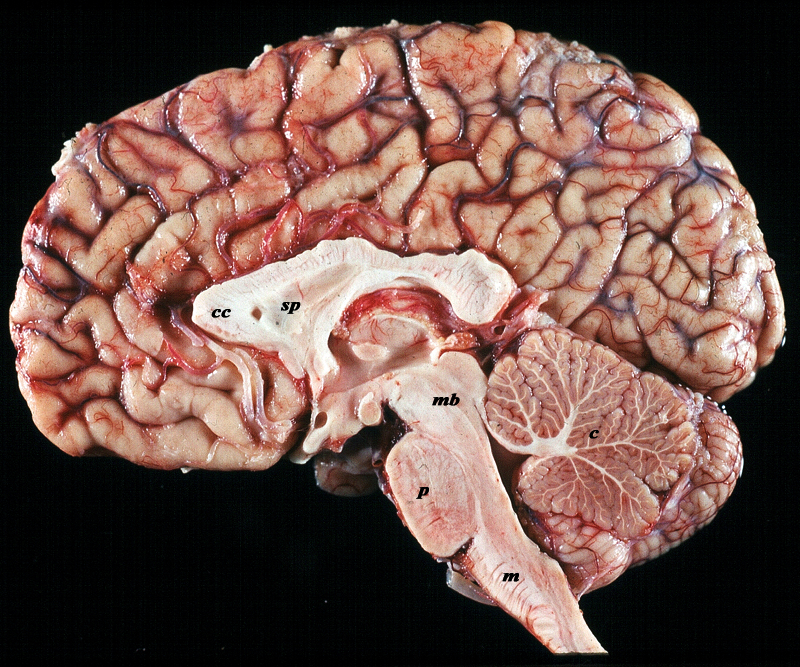
The Midbrain (mb) in Sagittal Projection
Bridge Between the Forebrain and Hindbrain |
| The midsagittal section view of brain reveals the distinctive shape position and character of the midline structures of the brain. The distinction between the character of the cerebral cortex which has a creamy color and the white matter exemplified by the corpus callosum (c) and septum pellucidum (sp) which are white, and the midbrain (mb) pons (p) and medulla (m) which are off white as opposed to the color of the cerebellum (c) which is light salmon pink is well demonstrated. The distinction between the folds of the cerebrum (gyri) and , and cerebellar folds (folia) are also exemplified in this image. The gyri of the cerebral hemispheres (gyri) are broad, irregular in shape, and course in different directions. The folds of the cerebellum on this view look like the branches of a tree. The cerebellum is smaller (Latin for little brain), and lies below the cerebral hemispheres.The relative sizes of the forebrain, midbrain and hindbrain and their components are well appreciated in this section.Image Courtesy of Thomas W.Smith, MD; Department of Pathology, University of Massachusetts Medical School. 97805b02 |
|
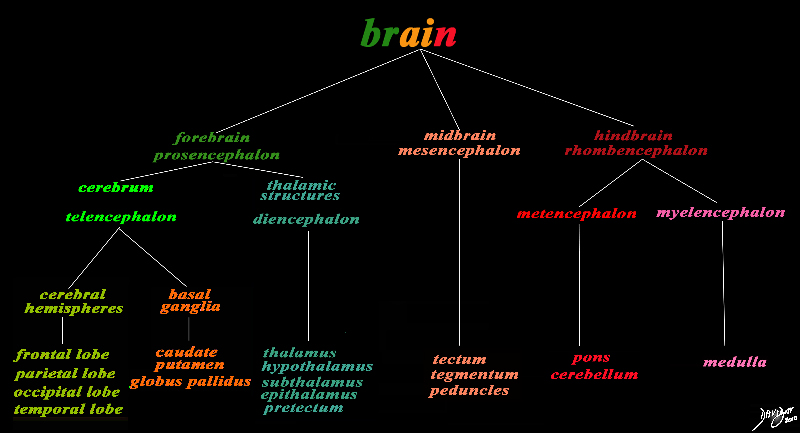
The Midbrain (mesencephalon) in Context |
|
The basic and simplest classification of the brain into forebrain midbrain and hindbrain is shown in this diagram and advanced to a more complex tree using the embryological and evolutionary terminologies.
The midbrain or mesencephalon is depicted in a salmon orange.
The forebrain consists of the cerebrum also called the prosencephalon, which contains the more advanced form of the brain and the thalamic structures which contain more basic structures. The cerebrum (telencephalon) itself consists of two cerebral hemispheres and paired basal ganglial structures. Each cerebral hemisphere will have gray and white matter distributed in the frontal parietal temporal and occipital lobe, with the basal ganglia being part of the gray matter deep in the cerebral hemispheres. The most important thalamic structures arising from the diencephalons include the thalamus itself and the hypothalamus. The midbrain (mesencepaholon) consists of the tectum tegmentum and cerebral peduncles. The hindbrain has two major branch points based on the evolutionary development. The pons and cerebellum(part of the metencephalon) are grouped and the medulla (part of the myelencephalon is the second branch.
Courtesy Ashley Davidoff MD Copyright 2010 All rights reserved 97686.8s
|
|
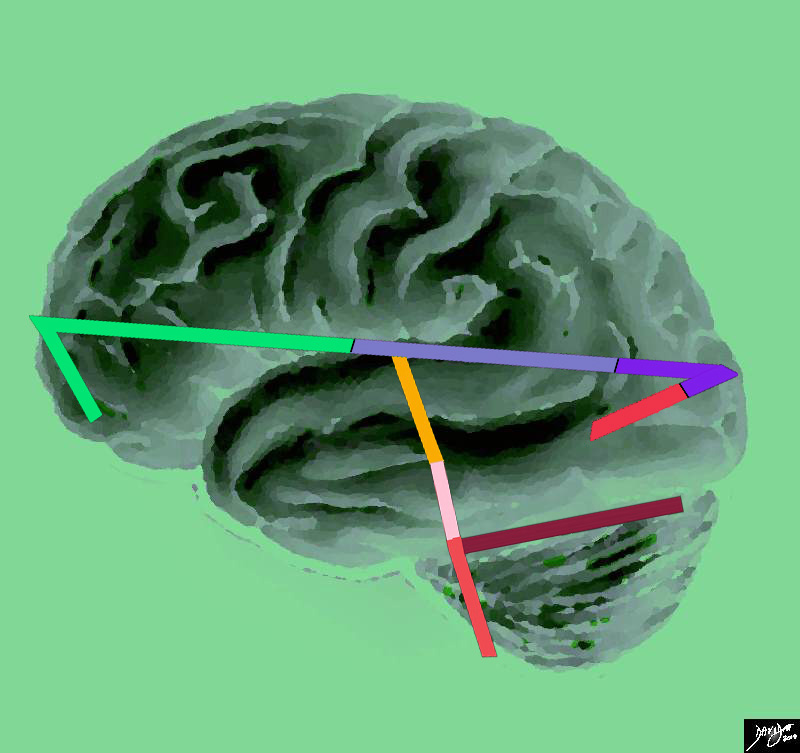
The Sagital Conceptual Vectors Overlying an External Lateral View of the Brain
The Midbrain in this Instance is Reflected in Orange |
|
The vectors of the brain from a side view are superimposed on a specimen of the brain, showing a long anteroposterior vector of the forebrain (light green) and a shorter more vertical vector consisting of the midbrain (orange) and the hind brain (salmon pink)
Courtesy Ashley Davidoff copyright 2010 all rights reserved 83029e04.83s |
|
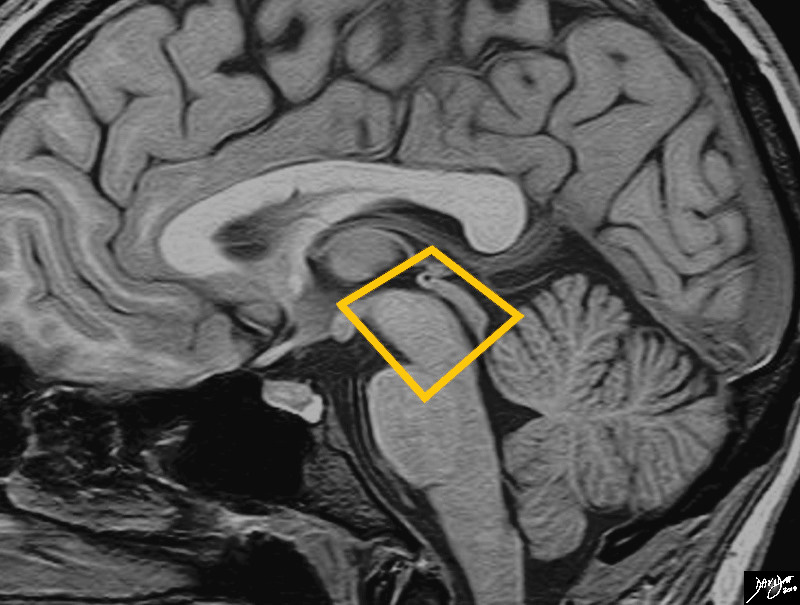
MRI of the Midbrain |
| The midbrain is an almost rectangular structure that bridges the forebrain and hindbrain. It is the smallest of the 3 major components of the brainCourtesy Philips Medical System copyright 2010 92141.3kb03.81s |
|

Axial Anatomic Specimen through the Midbrain
Periaqueductal Gray Around the Aqueduct of Sylvius |
| The anatomic section is an axial slice through the brain showing the structures of the midbrain. The most anterior structures of the midbrain are the cerebral peduncles followed by the substantia nigra, red nucleus, periaquaductal gray (PAG or central gray), aqueduct of Sylvius and finally the superior colliculus. Structures that are related to the midbrain anteriorly are the mamillary bodies and the optic tract. The hippocampus is positioned posterolaterally and the superior aspect of the cerebellum is seen posteriorly.Courtesy Department of Anatomy and Neurobiology at Boston University School of Medicine Dr. Jennifer Luebke , and Dr. Douglas Rosene 97140b03c.9 |
|
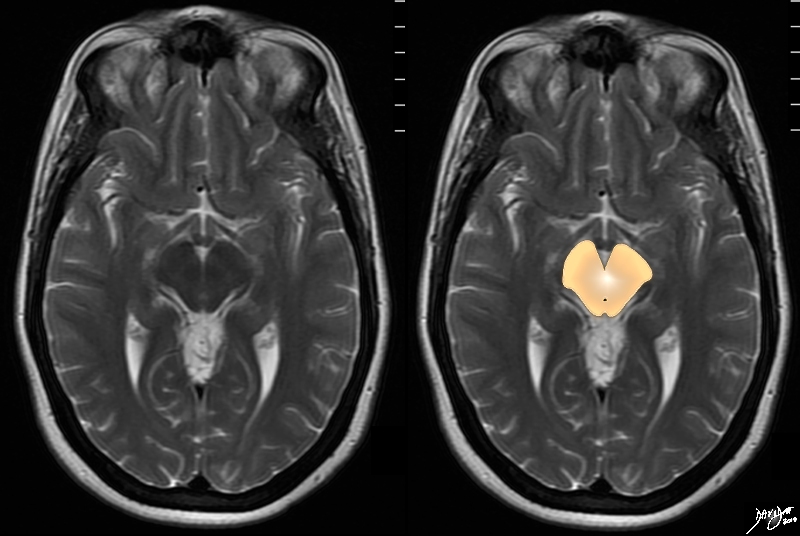
The Midbrain within the Context of the Whole Brain
T2 Weighted MRI |
| The T2 weighted MRI series focuses on the midbrain with characteristic shape and the small aqueduct of Sylvius posteriorly. It is surrounded by portions of the frontal lobe anteriorly, temporal lobes laterally and perhaps small portions of the occipital lobes posteriorly.Courtesy Ashley Davidoff MD copyright 2010 all rights reserved 94081.4kc01.8s |
|
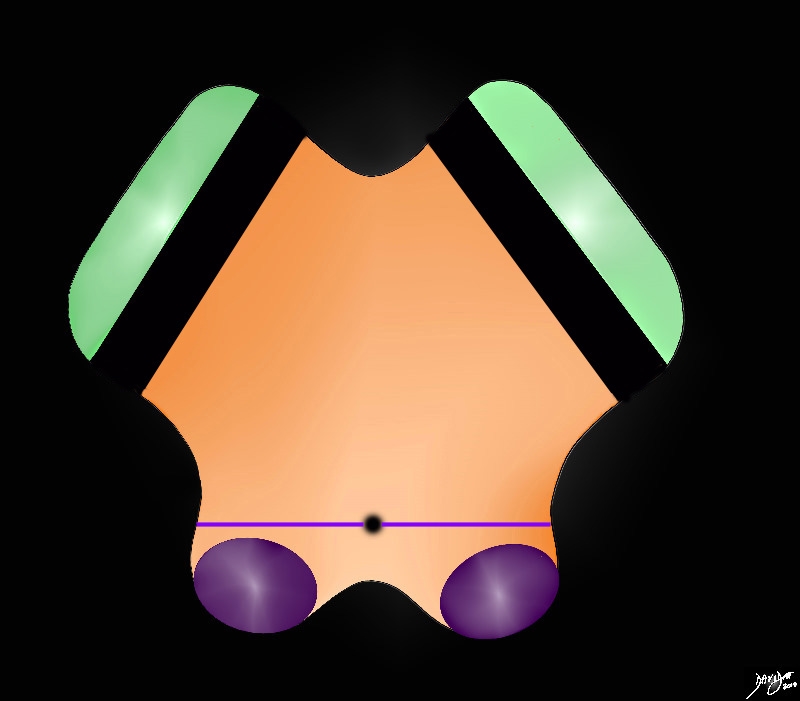
Peduncles Substantia Nigra Tegmentum Colliculi and Tectum |
| The anterior border of the midbrain incorporates the cerbral peduncles(green), and the substantia nigra (black ? just posterior to the peduncles. Between the substantia nigra and the aqueduct is an area of the midbrain called the tegmentum (floor of the midbrain) The posterior end of the midbrain is bordered by the colliculi (purple) in the tectum (roof) of the midbrain.Courtesy Ashley Davidoff MD copyright 2010 all rights reserved 94074b09b05b.83s |
|
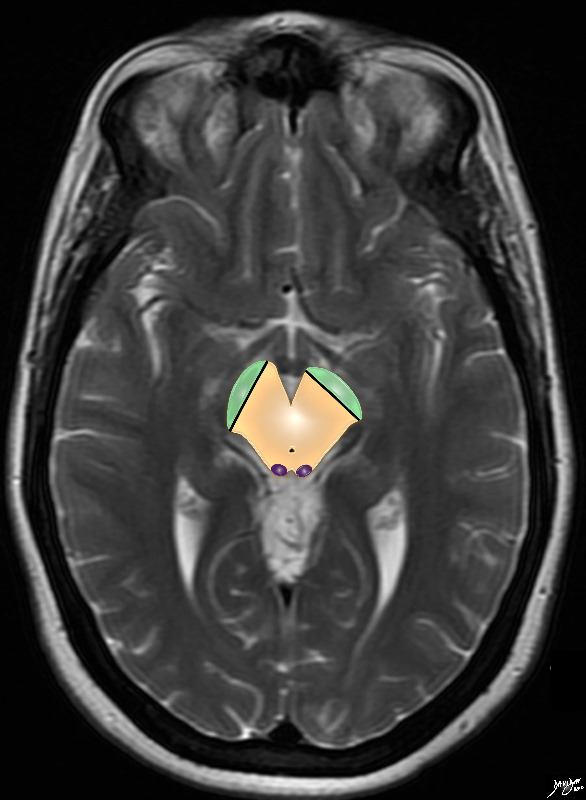
The Cerebral Crura and the Colliculi
The Tegmentum and the Tectum |
| The T2 weighted MRI series focuses on the midbrain with characteristic shape and the small aqueduct of Sylvius posteriorly. The cerebral crura are now shown anteriorly (green) in the peduncles and tegmentum, and the colliculi are shown posteriorly in the tectum or roof posteriorly.Courtesy Ashley Davidoff MD copyright 2010 all rights reserved 94081.4kb07.8s |
|
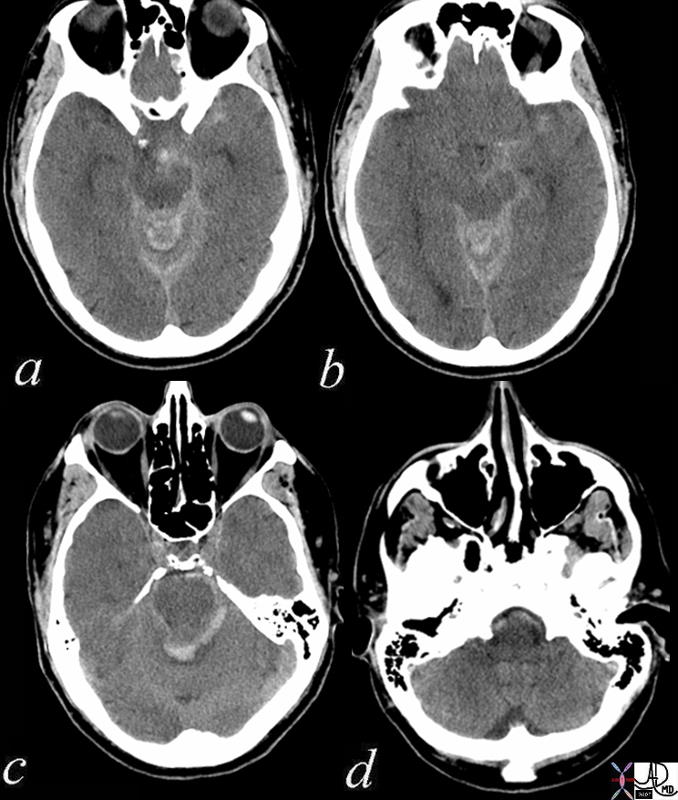
72034c01
|
| 72034c01 59 male presents with headache brain meninges tentorium circle of Willis ambient cisterns Berry aneurysm rupture subarachnoid blood subarachnoid hemorrhage headache CTscan Davidoff MD |
DOMElement Object
(
[schemaTypeInfo] =>
[tagName] => table
[firstElementChild] => (object value omitted)
[lastElementChild] => (object value omitted)
[childElementCount] => 1
[previousElementSibling] => (object value omitted)
[nextElementSibling] =>
[nodeName] => table
[nodeValue] =>
72034c01
72034c01 59 male presents with headache brain meninges tentorium circle of Willis ambient cisterns Berry aneurysm rupture subarachnoid blood subarachnoid hemorrhage headache CTscan Davidoff MD
[nodeType] => 1
[parentNode] => (object value omitted)
[childNodes] => (object value omitted)
[firstChild] => (object value omitted)
[lastChild] => (object value omitted)
[previousSibling] => (object value omitted)
[nextSibling] => (object value omitted)
[attributes] => (object value omitted)
[ownerDocument] => (object value omitted)
[namespaceURI] =>
[prefix] =>
[localName] => table
[baseURI] =>
[textContent] =>
72034c01
72034c01 59 male presents with headache brain meninges tentorium circle of Willis ambient cisterns Berry aneurysm rupture subarachnoid blood subarachnoid hemorrhage headache CTscan Davidoff MD
)
DOMElement Object
(
[schemaTypeInfo] =>
[tagName] => td
[firstElementChild] => (object value omitted)
[lastElementChild] => (object value omitted)
[childElementCount] => 1
[previousElementSibling] =>
[nextElementSibling] =>
[nodeName] => td
[nodeValue] => 72034c01 59 male presents with headache brain meninges tentorium circle of Willis ambient cisterns Berry aneurysm rupture subarachnoid blood subarachnoid hemorrhage headache CTscan Davidoff MD
[nodeType] => 1
[parentNode] => (object value omitted)
[childNodes] => (object value omitted)
[firstChild] => (object value omitted)
[lastChild] => (object value omitted)
[previousSibling] => (object value omitted)
[nextSibling] => (object value omitted)
[attributes] => (object value omitted)
[ownerDocument] => (object value omitted)
[namespaceURI] =>
[prefix] =>
[localName] => td
[baseURI] =>
[textContent] => 72034c01 59 male presents with headache brain meninges tentorium circle of Willis ambient cisterns Berry aneurysm rupture subarachnoid blood subarachnoid hemorrhage headache CTscan Davidoff MD
)
DOMElement Object
(
[schemaTypeInfo] =>
[tagName] => td
[firstElementChild] => (object value omitted)
[lastElementChild] => (object value omitted)
[childElementCount] => 2
[previousElementSibling] =>
[nextElementSibling] =>
[nodeName] => td
[nodeValue] =>
72034c01
[nodeType] => 1
[parentNode] => (object value omitted)
[childNodes] => (object value omitted)
[firstChild] => (object value omitted)
[lastChild] => (object value omitted)
[previousSibling] => (object value omitted)
[nextSibling] => (object value omitted)
[attributes] => (object value omitted)
[ownerDocument] => (object value omitted)
[namespaceURI] =>
[prefix] =>
[localName] => td
[baseURI] =>
[textContent] =>
72034c01
)
DOMElement Object
(
[schemaTypeInfo] =>
[tagName] => table
[firstElementChild] => (object value omitted)
[lastElementChild] => (object value omitted)
[childElementCount] => 1
[previousElementSibling] => (object value omitted)
[nextElementSibling] => (object value omitted)
[nodeName] => table
[nodeValue] =>
The Cerebral Crura and the Colliculi
The Tegmentum and the Tectum
The T2 weighted MRI series focuses on the midbrain with characteristic shape and the small aqueduct of Sylvius posteriorly. The cerebral crura are now shown anteriorly (green) in the peduncles and tegmentum, and the colliculi are shown posteriorly in the tectum or roof posteriorly.Courtesy Ashley Davidoff MD copyright 2010 all rights reserved 94081.4kb07.8s
[nodeType] => 1
[parentNode] => (object value omitted)
[childNodes] => (object value omitted)
[firstChild] => (object value omitted)
[lastChild] => (object value omitted)
[previousSibling] => (object value omitted)
[nextSibling] => (object value omitted)
[attributes] => (object value omitted)
[ownerDocument] => (object value omitted)
[namespaceURI] =>
[prefix] =>
[localName] => table
[baseURI] =>
[textContent] =>
The Cerebral Crura and the Colliculi
The Tegmentum and the Tectum
The T2 weighted MRI series focuses on the midbrain with characteristic shape and the small aqueduct of Sylvius posteriorly. The cerebral crura are now shown anteriorly (green) in the peduncles and tegmentum, and the colliculi are shown posteriorly in the tectum or roof posteriorly.Courtesy Ashley Davidoff MD copyright 2010 all rights reserved 94081.4kb07.8s
)
DOMElement Object
(
[schemaTypeInfo] =>
[tagName] => td
[firstElementChild] => (object value omitted)
[lastElementChild] => (object value omitted)
[childElementCount] => 2
[previousElementSibling] =>
[nextElementSibling] =>
[nodeName] => td
[nodeValue] => The T2 weighted MRI series focuses on the midbrain with characteristic shape and the small aqueduct of Sylvius posteriorly. The cerebral crura are now shown anteriorly (green) in the peduncles and tegmentum, and the colliculi are shown posteriorly in the tectum or roof posteriorly.Courtesy Ashley Davidoff MD copyright 2010 all rights reserved 94081.4kb07.8s
[nodeType] => 1
[parentNode] => (object value omitted)
[childNodes] => (object value omitted)
[firstChild] => (object value omitted)
[lastChild] => (object value omitted)
[previousSibling] => (object value omitted)
[nextSibling] => (object value omitted)
[attributes] => (object value omitted)
[ownerDocument] => (object value omitted)
[namespaceURI] =>
[prefix] =>
[localName] => td
[baseURI] =>
[textContent] => The T2 weighted MRI series focuses on the midbrain with characteristic shape and the small aqueduct of Sylvius posteriorly. The cerebral crura are now shown anteriorly (green) in the peduncles and tegmentum, and the colliculi are shown posteriorly in the tectum or roof posteriorly.Courtesy Ashley Davidoff MD copyright 2010 all rights reserved 94081.4kb07.8s
)
DOMElement Object
(
[schemaTypeInfo] =>
[tagName] => td
[firstElementChild] => (object value omitted)
[lastElementChild] => (object value omitted)
[childElementCount] => 3
[previousElementSibling] =>
[nextElementSibling] =>
[nodeName] => td
[nodeValue] =>
The Cerebral Crura and the Colliculi
The Tegmentum and the Tectum
[nodeType] => 1
[parentNode] => (object value omitted)
[childNodes] => (object value omitted)
[firstChild] => (object value omitted)
[lastChild] => (object value omitted)
[previousSibling] => (object value omitted)
[nextSibling] => (object value omitted)
[attributes] => (object value omitted)
[ownerDocument] => (object value omitted)
[namespaceURI] =>
[prefix] =>
[localName] => td
[baseURI] =>
[textContent] =>
The Cerebral Crura and the Colliculi
The Tegmentum and the Tectum
)
DOMElement Object
(
[schemaTypeInfo] =>
[tagName] => table
[firstElementChild] => (object value omitted)
[lastElementChild] => (object value omitted)
[childElementCount] => 1
[previousElementSibling] => (object value omitted)
[nextElementSibling] => (object value omitted)
[nodeName] => table
[nodeValue] =>
Peduncles Substantia Nigra Tegmentum Colliculi and Tectum
The anterior border of the midbrain incorporates the cerbral peduncles(green), and the substantia nigra (black ? just posterior to the peduncles. Between the substantia nigra and the aqueduct is an area of the midbrain called the tegmentum (floor of the midbrain) The posterior end of the midbrain is bordered by the colliculi (purple) in the tectum (roof) of the midbrain.Courtesy Ashley Davidoff MD copyright 2010 all rights reserved 94074b09b05b.83s
[nodeType] => 1
[parentNode] => (object value omitted)
[childNodes] => (object value omitted)
[firstChild] => (object value omitted)
[lastChild] => (object value omitted)
[previousSibling] => (object value omitted)
[nextSibling] => (object value omitted)
[attributes] => (object value omitted)
[ownerDocument] => (object value omitted)
[namespaceURI] =>
[prefix] =>
[localName] => table
[baseURI] =>
[textContent] =>
Peduncles Substantia Nigra Tegmentum Colliculi and Tectum
The anterior border of the midbrain incorporates the cerbral peduncles(green), and the substantia nigra (black ? just posterior to the peduncles. Between the substantia nigra and the aqueduct is an area of the midbrain called the tegmentum (floor of the midbrain) The posterior end of the midbrain is bordered by the colliculi (purple) in the tectum (roof) of the midbrain.Courtesy Ashley Davidoff MD copyright 2010 all rights reserved 94074b09b05b.83s
)
DOMElement Object
(
[schemaTypeInfo] =>
[tagName] => td
[firstElementChild] => (object value omitted)
[lastElementChild] => (object value omitted)
[childElementCount] => 2
[previousElementSibling] =>
[nextElementSibling] =>
[nodeName] => td
[nodeValue] => The anterior border of the midbrain incorporates the cerbral peduncles(green), and the substantia nigra (black ? just posterior to the peduncles. Between the substantia nigra and the aqueduct is an area of the midbrain called the tegmentum (floor of the midbrain) The posterior end of the midbrain is bordered by the colliculi (purple) in the tectum (roof) of the midbrain.Courtesy Ashley Davidoff MD copyright 2010 all rights reserved 94074b09b05b.83s
[nodeType] => 1
[parentNode] => (object value omitted)
[childNodes] => (object value omitted)
[firstChild] => (object value omitted)
[lastChild] => (object value omitted)
[previousSibling] => (object value omitted)
[nextSibling] => (object value omitted)
[attributes] => (object value omitted)
[ownerDocument] => (object value omitted)
[namespaceURI] =>
[prefix] =>
[localName] => td
[baseURI] =>
[textContent] => The anterior border of the midbrain incorporates the cerbral peduncles(green), and the substantia nigra (black ? just posterior to the peduncles. Between the substantia nigra and the aqueduct is an area of the midbrain called the tegmentum (floor of the midbrain) The posterior end of the midbrain is bordered by the colliculi (purple) in the tectum (roof) of the midbrain.Courtesy Ashley Davidoff MD copyright 2010 all rights reserved 94074b09b05b.83s
)
DOMElement Object
(
[schemaTypeInfo] =>
[tagName] => td
[firstElementChild] => (object value omitted)
[lastElementChild] => (object value omitted)
[childElementCount] => 2
[previousElementSibling] =>
[nextElementSibling] =>
[nodeName] => td
[nodeValue] =>
Peduncles Substantia Nigra Tegmentum Colliculi and Tectum
[nodeType] => 1
[parentNode] => (object value omitted)
[childNodes] => (object value omitted)
[firstChild] => (object value omitted)
[lastChild] => (object value omitted)
[previousSibling] => (object value omitted)
[nextSibling] => (object value omitted)
[attributes] => (object value omitted)
[ownerDocument] => (object value omitted)
[namespaceURI] =>
[prefix] =>
[localName] => td
[baseURI] =>
[textContent] =>
Peduncles Substantia Nigra Tegmentum Colliculi and Tectum
)
DOMElement Object
(
[schemaTypeInfo] =>
[tagName] => table
[firstElementChild] => (object value omitted)
[lastElementChild] => (object value omitted)
[childElementCount] => 1
[previousElementSibling] => (object value omitted)
[nextElementSibling] => (object value omitted)
[nodeName] => table
[nodeValue] =>
The Midbrain within the Context of the Whole Brain
T2 Weighted MRI
The T2 weighted MRI series focuses on the midbrain with characteristic shape and the small aqueduct of Sylvius posteriorly. It is surrounded by portions of the frontal lobe anteriorly, temporal lobes laterally and perhaps small portions of the occipital lobes posteriorly.Courtesy Ashley Davidoff MD copyright 2010 all rights reserved 94081.4kc01.8s
[nodeType] => 1
[parentNode] => (object value omitted)
[childNodes] => (object value omitted)
[firstChild] => (object value omitted)
[lastChild] => (object value omitted)
[previousSibling] => (object value omitted)
[nextSibling] => (object value omitted)
[attributes] => (object value omitted)
[ownerDocument] => (object value omitted)
[namespaceURI] =>
[prefix] =>
[localName] => table
[baseURI] =>
[textContent] =>
The Midbrain within the Context of the Whole Brain
T2 Weighted MRI
The T2 weighted MRI series focuses on the midbrain with characteristic shape and the small aqueduct of Sylvius posteriorly. It is surrounded by portions of the frontal lobe anteriorly, temporal lobes laterally and perhaps small portions of the occipital lobes posteriorly.Courtesy Ashley Davidoff MD copyright 2010 all rights reserved 94081.4kc01.8s
)
DOMElement Object
(
[schemaTypeInfo] =>
[tagName] => td
[firstElementChild] => (object value omitted)
[lastElementChild] => (object value omitted)
[childElementCount] => 2
[previousElementSibling] =>
[nextElementSibling] =>
[nodeName] => td
[nodeValue] => The T2 weighted MRI series focuses on the midbrain with characteristic shape and the small aqueduct of Sylvius posteriorly. It is surrounded by portions of the frontal lobe anteriorly, temporal lobes laterally and perhaps small portions of the occipital lobes posteriorly.Courtesy Ashley Davidoff MD copyright 2010 all rights reserved 94081.4kc01.8s
[nodeType] => 1
[parentNode] => (object value omitted)
[childNodes] => (object value omitted)
[firstChild] => (object value omitted)
[lastChild] => (object value omitted)
[previousSibling] => (object value omitted)
[nextSibling] => (object value omitted)
[attributes] => (object value omitted)
[ownerDocument] => (object value omitted)
[namespaceURI] =>
[prefix] =>
[localName] => td
[baseURI] =>
[textContent] => The T2 weighted MRI series focuses on the midbrain with characteristic shape and the small aqueduct of Sylvius posteriorly. It is surrounded by portions of the frontal lobe anteriorly, temporal lobes laterally and perhaps small portions of the occipital lobes posteriorly.Courtesy Ashley Davidoff MD copyright 2010 all rights reserved 94081.4kc01.8s
)
DOMElement Object
(
[schemaTypeInfo] =>
[tagName] => td
[firstElementChild] => (object value omitted)
[lastElementChild] => (object value omitted)
[childElementCount] => 3
[previousElementSibling] =>
[nextElementSibling] =>
[nodeName] => td
[nodeValue] =>
The Midbrain within the Context of the Whole Brain
T2 Weighted MRI
[nodeType] => 1
[parentNode] => (object value omitted)
[childNodes] => (object value omitted)
[firstChild] => (object value omitted)
[lastChild] => (object value omitted)
[previousSibling] => (object value omitted)
[nextSibling] => (object value omitted)
[attributes] => (object value omitted)
[ownerDocument] => (object value omitted)
[namespaceURI] =>
[prefix] =>
[localName] => td
[baseURI] =>
[textContent] =>
The Midbrain within the Context of the Whole Brain
T2 Weighted MRI
)
DOMElement Object
(
[schemaTypeInfo] =>
[tagName] => table
[firstElementChild] => (object value omitted)
[lastElementChild] => (object value omitted)
[childElementCount] => 1
[previousElementSibling] => (object value omitted)
[nextElementSibling] => (object value omitted)
[nodeName] => table
[nodeValue] =>
Axial Anatomic Specimen through the Midbrain
Periaqueductal Gray Around the Aqueduct of Sylvius
The anatomic section is an axial slice through the brain showing the structures of the midbrain. The most anterior structures of the midbrain are the cerebral peduncles followed by the substantia nigra, red nucleus, periaquaductal gray (PAG or central gray), aqueduct of Sylvius and finally the superior colliculus. Structures that are related to the midbrain anteriorly are the mamillary bodies and the optic tract. The hippocampus is positioned posterolaterally and the superior aspect of the cerebellum is seen posteriorly.Courtesy Department of Anatomy and Neurobiology at Boston University School of Medicine Dr. Jennifer Luebke , and Dr. Douglas Rosene 97140b03c.9
[nodeType] => 1
[parentNode] => (object value omitted)
[childNodes] => (object value omitted)
[firstChild] => (object value omitted)
[lastChild] => (object value omitted)
[previousSibling] => (object value omitted)
[nextSibling] => (object value omitted)
[attributes] => (object value omitted)
[ownerDocument] => (object value omitted)
[namespaceURI] =>
[prefix] =>
[localName] => table
[baseURI] =>
[textContent] =>
Axial Anatomic Specimen through the Midbrain
Periaqueductal Gray Around the Aqueduct of Sylvius
The anatomic section is an axial slice through the brain showing the structures of the midbrain. The most anterior structures of the midbrain are the cerebral peduncles followed by the substantia nigra, red nucleus, periaquaductal gray (PAG or central gray), aqueduct of Sylvius and finally the superior colliculus. Structures that are related to the midbrain anteriorly are the mamillary bodies and the optic tract. The hippocampus is positioned posterolaterally and the superior aspect of the cerebellum is seen posteriorly.Courtesy Department of Anatomy and Neurobiology at Boston University School of Medicine Dr. Jennifer Luebke , and Dr. Douglas Rosene 97140b03c.9
)
DOMElement Object
(
[schemaTypeInfo] =>
[tagName] => td
[firstElementChild] => (object value omitted)
[lastElementChild] => (object value omitted)
[childElementCount] => 2
[previousElementSibling] =>
[nextElementSibling] =>
[nodeName] => td
[nodeValue] => The anatomic section is an axial slice through the brain showing the structures of the midbrain. The most anterior structures of the midbrain are the cerebral peduncles followed by the substantia nigra, red nucleus, periaquaductal gray (PAG or central gray), aqueduct of Sylvius and finally the superior colliculus. Structures that are related to the midbrain anteriorly are the mamillary bodies and the optic tract. The hippocampus is positioned posterolaterally and the superior aspect of the cerebellum is seen posteriorly.Courtesy Department of Anatomy and Neurobiology at Boston University School of Medicine Dr. Jennifer Luebke , and Dr. Douglas Rosene 97140b03c.9
[nodeType] => 1
[parentNode] => (object value omitted)
[childNodes] => (object value omitted)
[firstChild] => (object value omitted)
[lastChild] => (object value omitted)
[previousSibling] => (object value omitted)
[nextSibling] => (object value omitted)
[attributes] => (object value omitted)
[ownerDocument] => (object value omitted)
[namespaceURI] =>
[prefix] =>
[localName] => td
[baseURI] =>
[textContent] => The anatomic section is an axial slice through the brain showing the structures of the midbrain. The most anterior structures of the midbrain are the cerebral peduncles followed by the substantia nigra, red nucleus, periaquaductal gray (PAG or central gray), aqueduct of Sylvius and finally the superior colliculus. Structures that are related to the midbrain anteriorly are the mamillary bodies and the optic tract. The hippocampus is positioned posterolaterally and the superior aspect of the cerebellum is seen posteriorly.Courtesy Department of Anatomy and Neurobiology at Boston University School of Medicine Dr. Jennifer Luebke , and Dr. Douglas Rosene 97140b03c.9
)
DOMElement Object
(
[schemaTypeInfo] =>
[tagName] => td
[firstElementChild] => (object value omitted)
[lastElementChild] => (object value omitted)
[childElementCount] => 3
[previousElementSibling] =>
[nextElementSibling] =>
[nodeName] => td
[nodeValue] =>
Axial Anatomic Specimen through the Midbrain
Periaqueductal Gray Around the Aqueduct of Sylvius
[nodeType] => 1
[parentNode] => (object value omitted)
[childNodes] => (object value omitted)
[firstChild] => (object value omitted)
[lastChild] => (object value omitted)
[previousSibling] => (object value omitted)
[nextSibling] => (object value omitted)
[attributes] => (object value omitted)
[ownerDocument] => (object value omitted)
[namespaceURI] =>
[prefix] =>
[localName] => td
[baseURI] =>
[textContent] =>
Axial Anatomic Specimen through the Midbrain
Periaqueductal Gray Around the Aqueduct of Sylvius
)
DOMElement Object
(
[schemaTypeInfo] =>
[tagName] => table
[firstElementChild] => (object value omitted)
[lastElementChild] => (object value omitted)
[childElementCount] => 1
[previousElementSibling] => (object value omitted)
[nextElementSibling] => (object value omitted)
[nodeName] => table
[nodeValue] =>
MRI of the Midbrain
The midbrain is an almost rectangular structure that bridges the forebrain and hindbrain. It is the smallest of the 3 major components of the brainCourtesy Philips Medical System copyright 2010 92141.3kb03.81s
[nodeType] => 1
[parentNode] => (object value omitted)
[childNodes] => (object value omitted)
[firstChild] => (object value omitted)
[lastChild] => (object value omitted)
[previousSibling] => (object value omitted)
[nextSibling] => (object value omitted)
[attributes] => (object value omitted)
[ownerDocument] => (object value omitted)
[namespaceURI] =>
[prefix] =>
[localName] => table
[baseURI] =>
[textContent] =>
MRI of the Midbrain
The midbrain is an almost rectangular structure that bridges the forebrain and hindbrain. It is the smallest of the 3 major components of the brainCourtesy Philips Medical System copyright 2010 92141.3kb03.81s
)
DOMElement Object
(
[schemaTypeInfo] =>
[tagName] => td
[firstElementChild] => (object value omitted)
[lastElementChild] => (object value omitted)
[childElementCount] => 2
[previousElementSibling] =>
[nextElementSibling] =>
[nodeName] => td
[nodeValue] => The midbrain is an almost rectangular structure that bridges the forebrain and hindbrain. It is the smallest of the 3 major components of the brainCourtesy Philips Medical System copyright 2010 92141.3kb03.81s
[nodeType] => 1
[parentNode] => (object value omitted)
[childNodes] => (object value omitted)
[firstChild] => (object value omitted)
[lastChild] => (object value omitted)
[previousSibling] => (object value omitted)
[nextSibling] => (object value omitted)
[attributes] => (object value omitted)
[ownerDocument] => (object value omitted)
[namespaceURI] =>
[prefix] =>
[localName] => td
[baseURI] =>
[textContent] => The midbrain is an almost rectangular structure that bridges the forebrain and hindbrain. It is the smallest of the 3 major components of the brainCourtesy Philips Medical System copyright 2010 92141.3kb03.81s
)
DOMElement Object
(
[schemaTypeInfo] =>
[tagName] => td
[firstElementChild] => (object value omitted)
[lastElementChild] => (object value omitted)
[childElementCount] => 2
[previousElementSibling] =>
[nextElementSibling] =>
[nodeName] => td
[nodeValue] =>
MRI of the Midbrain
[nodeType] => 1
[parentNode] => (object value omitted)
[childNodes] => (object value omitted)
[firstChild] => (object value omitted)
[lastChild] => (object value omitted)
[previousSibling] => (object value omitted)
[nextSibling] => (object value omitted)
[attributes] => (object value omitted)
[ownerDocument] => (object value omitted)
[namespaceURI] =>
[prefix] =>
[localName] => td
[baseURI] =>
[textContent] =>
MRI of the Midbrain
)
DOMElement Object
(
[schemaTypeInfo] =>
[tagName] => table
[firstElementChild] => (object value omitted)
[lastElementChild] => (object value omitted)
[childElementCount] => 1
[previousElementSibling] => (object value omitted)
[nextElementSibling] => (object value omitted)
[nodeName] => table
[nodeValue] =>
The Sagital Conceptual Vectors Overlying an External Lateral View of the Brain
The Midbrain in this Instance is Reflected in Orange
The vectors of the brain from a side view are superimposed on a specimen of the brain, showing a long anteroposterior vector of the forebrain (light green) and a shorter more vertical vector consisting of the midbrain (orange) and the hind brain (salmon pink)
Courtesy Ashley Davidoff copyright 2010 all rights reserved 83029e04.83s
[nodeType] => 1
[parentNode] => (object value omitted)
[childNodes] => (object value omitted)
[firstChild] => (object value omitted)
[lastChild] => (object value omitted)
[previousSibling] => (object value omitted)
[nextSibling] => (object value omitted)
[attributes] => (object value omitted)
[ownerDocument] => (object value omitted)
[namespaceURI] =>
[prefix] =>
[localName] => table
[baseURI] =>
[textContent] =>
The Sagital Conceptual Vectors Overlying an External Lateral View of the Brain
The Midbrain in this Instance is Reflected in Orange
The vectors of the brain from a side view are superimposed on a specimen of the brain, showing a long anteroposterior vector of the forebrain (light green) and a shorter more vertical vector consisting of the midbrain (orange) and the hind brain (salmon pink)
Courtesy Ashley Davidoff copyright 2010 all rights reserved 83029e04.83s
)
DOMElement Object
(
[schemaTypeInfo] =>
[tagName] => td
[firstElementChild] => (object value omitted)
[lastElementChild] => (object value omitted)
[childElementCount] => 2
[previousElementSibling] =>
[nextElementSibling] =>
[nodeName] => td
[nodeValue] =>
The vectors of the brain from a side view are superimposed on a specimen of the brain, showing a long anteroposterior vector of the forebrain (light green) and a shorter more vertical vector consisting of the midbrain (orange) and the hind brain (salmon pink)
Courtesy Ashley Davidoff copyright 2010 all rights reserved 83029e04.83s
[nodeType] => 1
[parentNode] => (object value omitted)
[childNodes] => (object value omitted)
[firstChild] => (object value omitted)
[lastChild] => (object value omitted)
[previousSibling] => (object value omitted)
[nextSibling] => (object value omitted)
[attributes] => (object value omitted)
[ownerDocument] => (object value omitted)
[namespaceURI] =>
[prefix] =>
[localName] => td
[baseURI] =>
[textContent] =>
The vectors of the brain from a side view are superimposed on a specimen of the brain, showing a long anteroposterior vector of the forebrain (light green) and a shorter more vertical vector consisting of the midbrain (orange) and the hind brain (salmon pink)
Courtesy Ashley Davidoff copyright 2010 all rights reserved 83029e04.83s
)
DOMElement Object
(
[schemaTypeInfo] =>
[tagName] => td
[firstElementChild] => (object value omitted)
[lastElementChild] => (object value omitted)
[childElementCount] => 3
[previousElementSibling] =>
[nextElementSibling] =>
[nodeName] => td
[nodeValue] =>
The Sagital Conceptual Vectors Overlying an External Lateral View of the Brain
The Midbrain in this Instance is Reflected in Orange
[nodeType] => 1
[parentNode] => (object value omitted)
[childNodes] => (object value omitted)
[firstChild] => (object value omitted)
[lastChild] => (object value omitted)
[previousSibling] => (object value omitted)
[nextSibling] => (object value omitted)
[attributes] => (object value omitted)
[ownerDocument] => (object value omitted)
[namespaceURI] =>
[prefix] =>
[localName] => td
[baseURI] =>
[textContent] =>
The Sagital Conceptual Vectors Overlying an External Lateral View of the Brain
The Midbrain in this Instance is Reflected in Orange
)
DOMElement Object
(
[schemaTypeInfo] =>
[tagName] => table
[firstElementChild] => (object value omitted)
[lastElementChild] => (object value omitted)
[childElementCount] => 1
[previousElementSibling] => (object value omitted)
[nextElementSibling] => (object value omitted)
[nodeName] => table
[nodeValue] =>
The Midbrain (mesencephalon) in Context
The basic and simplest classification of the brain into forebrain midbrain and hindbrain is shown in this diagram and advanced to a more complex tree using the embryological and evolutionary terminologies.
The midbrain or mesencephalon is depicted in a salmon orange.
The forebrain consists of the cerebrum also called the prosencephalon, which contains the more advanced form of the brain and the thalamic structures which contain more basic structures. The cerebrum (telencephalon) itself consists of two cerebral hemispheres and paired basal ganglial structures. Each cerebral hemisphere will have gray and white matter distributed in the frontal parietal temporal and occipital lobe, with the basal ganglia being part of the gray matter deep in the cerebral hemispheres. The most important thalamic structures arising from the diencephalons include the thalamus itself and the hypothalamus. The midbrain (mesencepaholon) consists of the tectum tegmentum and cerebral peduncles. The hindbrain has two major branch points based on the evolutionary development. The pons and cerebellum(part of the metencephalon) are grouped and the medulla (part of the myelencephalon is the second branch.
Courtesy Ashley Davidoff MD Copyright 2010 All rights reserved 97686.8s
[nodeType] => 1
[parentNode] => (object value omitted)
[childNodes] => (object value omitted)
[firstChild] => (object value omitted)
[lastChild] => (object value omitted)
[previousSibling] => (object value omitted)
[nextSibling] => (object value omitted)
[attributes] => (object value omitted)
[ownerDocument] => (object value omitted)
[namespaceURI] =>
[prefix] =>
[localName] => table
[baseURI] =>
[textContent] =>
The Midbrain (mesencephalon) in Context
The basic and simplest classification of the brain into forebrain midbrain and hindbrain is shown in this diagram and advanced to a more complex tree using the embryological and evolutionary terminologies.
The midbrain or mesencephalon is depicted in a salmon orange.
The forebrain consists of the cerebrum also called the prosencephalon, which contains the more advanced form of the brain and the thalamic structures which contain more basic structures. The cerebrum (telencephalon) itself consists of two cerebral hemispheres and paired basal ganglial structures. Each cerebral hemisphere will have gray and white matter distributed in the frontal parietal temporal and occipital lobe, with the basal ganglia being part of the gray matter deep in the cerebral hemispheres. The most important thalamic structures arising from the diencephalons include the thalamus itself and the hypothalamus. The midbrain (mesencepaholon) consists of the tectum tegmentum and cerebral peduncles. The hindbrain has two major branch points based on the evolutionary development. The pons and cerebellum(part of the metencephalon) are grouped and the medulla (part of the myelencephalon is the second branch.
Courtesy Ashley Davidoff MD Copyright 2010 All rights reserved 97686.8s
)
DOMElement Object
(
[schemaTypeInfo] =>
[tagName] => td
[firstElementChild] => (object value omitted)
[lastElementChild] => (object value omitted)
[childElementCount] => 4
[previousElementSibling] =>
[nextElementSibling] =>
[nodeName] => td
[nodeValue] =>
The basic and simplest classification of the brain into forebrain midbrain and hindbrain is shown in this diagram and advanced to a more complex tree using the embryological and evolutionary terminologies.
The midbrain or mesencephalon is depicted in a salmon orange.
The forebrain consists of the cerebrum also called the prosencephalon, which contains the more advanced form of the brain and the thalamic structures which contain more basic structures. The cerebrum (telencephalon) itself consists of two cerebral hemispheres and paired basal ganglial structures. Each cerebral hemisphere will have gray and white matter distributed in the frontal parietal temporal and occipital lobe, with the basal ganglia being part of the gray matter deep in the cerebral hemispheres. The most important thalamic structures arising from the diencephalons include the thalamus itself and the hypothalamus. The midbrain (mesencepaholon) consists of the tectum tegmentum and cerebral peduncles. The hindbrain has two major branch points based on the evolutionary development. The pons and cerebellum(part of the metencephalon) are grouped and the medulla (part of the myelencephalon is the second branch.
Courtesy Ashley Davidoff MD Copyright 2010 All rights reserved 97686.8s
[nodeType] => 1
[parentNode] => (object value omitted)
[childNodes] => (object value omitted)
[firstChild] => (object value omitted)
[lastChild] => (object value omitted)
[previousSibling] => (object value omitted)
[nextSibling] => (object value omitted)
[attributes] => (object value omitted)
[ownerDocument] => (object value omitted)
[namespaceURI] =>
[prefix] =>
[localName] => td
[baseURI] =>
[textContent] =>
The basic and simplest classification of the brain into forebrain midbrain and hindbrain is shown in this diagram and advanced to a more complex tree using the embryological and evolutionary terminologies.
The midbrain or mesencephalon is depicted in a salmon orange.
The forebrain consists of the cerebrum also called the prosencephalon, which contains the more advanced form of the brain and the thalamic structures which contain more basic structures. The cerebrum (telencephalon) itself consists of two cerebral hemispheres and paired basal ganglial structures. Each cerebral hemisphere will have gray and white matter distributed in the frontal parietal temporal and occipital lobe, with the basal ganglia being part of the gray matter deep in the cerebral hemispheres. The most important thalamic structures arising from the diencephalons include the thalamus itself and the hypothalamus. The midbrain (mesencepaholon) consists of the tectum tegmentum and cerebral peduncles. The hindbrain has two major branch points based on the evolutionary development. The pons and cerebellum(part of the metencephalon) are grouped and the medulla (part of the myelencephalon is the second branch.
Courtesy Ashley Davidoff MD Copyright 2010 All rights reserved 97686.8s
)
DOMElement Object
(
[schemaTypeInfo] =>
[tagName] => td
[firstElementChild] => (object value omitted)
[lastElementChild] => (object value omitted)
[childElementCount] => 2
[previousElementSibling] =>
[nextElementSibling] =>
[nodeName] => td
[nodeValue] =>
The Midbrain (mesencephalon) in Context
[nodeType] => 1
[parentNode] => (object value omitted)
[childNodes] => (object value omitted)
[firstChild] => (object value omitted)
[lastChild] => (object value omitted)
[previousSibling] => (object value omitted)
[nextSibling] => (object value omitted)
[attributes] => (object value omitted)
[ownerDocument] => (object value omitted)
[namespaceURI] =>
[prefix] =>
[localName] => td
[baseURI] =>
[textContent] =>
The Midbrain (mesencephalon) in Context
)
DOMElement Object
(
[schemaTypeInfo] =>
[tagName] => table
[firstElementChild] => (object value omitted)
[lastElementChild] => (object value omitted)
[childElementCount] => 1
[previousElementSibling] => (object value omitted)
[nextElementSibling] => (object value omitted)
[nodeName] => table
[nodeValue] =>
The Midbrain (mb) in Sagittal Projection
Bridge Between the Forebrain and Hindbrain
The midsagittal section view of brain reveals the distinctive shape position and character of the midline structures of the brain. The distinction between the character of the cerebral cortex which has a creamy color and the white matter exemplified by the corpus callosum (c) and septum pellucidum (sp) which are white, and the midbrain (mb) pons (p) and medulla (m) which are off white as opposed to the color of the cerebellum (c) which is light salmon pink is well demonstrated. The distinction between the folds of the cerebrum (gyri) and , and cerebellar folds (folia) are also exemplified in this image. The gyri of the cerebral hemispheres (gyri) are broad, irregular in shape, and course in different directions. The folds of the cerebellum on this view look like the branches of a tree. The cerebellum is smaller (Latin for little brain), and lies below the cerebral hemispheres.The relative sizes of the forebrain, midbrain and hindbrain and their components are well appreciated in this section.Image Courtesy of Thomas W.Smith, MD; Department of Pathology, University of Massachusetts Medical School. 97805b02
[nodeType] => 1
[parentNode] => (object value omitted)
[childNodes] => (object value omitted)
[firstChild] => (object value omitted)
[lastChild] => (object value omitted)
[previousSibling] => (object value omitted)
[nextSibling] => (object value omitted)
[attributes] => (object value omitted)
[ownerDocument] => (object value omitted)
[namespaceURI] =>
[prefix] =>
[localName] => table
[baseURI] =>
[textContent] =>
The Midbrain (mb) in Sagittal Projection
Bridge Between the Forebrain and Hindbrain
The midsagittal section view of brain reveals the distinctive shape position and character of the midline structures of the brain. The distinction between the character of the cerebral cortex which has a creamy color and the white matter exemplified by the corpus callosum (c) and septum pellucidum (sp) which are white, and the midbrain (mb) pons (p) and medulla (m) which are off white as opposed to the color of the cerebellum (c) which is light salmon pink is well demonstrated. The distinction between the folds of the cerebrum (gyri) and , and cerebellar folds (folia) are also exemplified in this image. The gyri of the cerebral hemispheres (gyri) are broad, irregular in shape, and course in different directions. The folds of the cerebellum on this view look like the branches of a tree. The cerebellum is smaller (Latin for little brain), and lies below the cerebral hemispheres.The relative sizes of the forebrain, midbrain and hindbrain and their components are well appreciated in this section.Image Courtesy of Thomas W.Smith, MD; Department of Pathology, University of Massachusetts Medical School. 97805b02
)
DOMElement Object
(
[schemaTypeInfo] =>
[tagName] => td
[firstElementChild] => (object value omitted)
[lastElementChild] => (object value omitted)
[childElementCount] => 2
[previousElementSibling] =>
[nextElementSibling] =>
[nodeName] => td
[nodeValue] => The midsagittal section view of brain reveals the distinctive shape position and character of the midline structures of the brain. The distinction between the character of the cerebral cortex which has a creamy color and the white matter exemplified by the corpus callosum (c) and septum pellucidum (sp) which are white, and the midbrain (mb) pons (p) and medulla (m) which are off white as opposed to the color of the cerebellum (c) which is light salmon pink is well demonstrated. The distinction between the folds of the cerebrum (gyri) and , and cerebellar folds (folia) are also exemplified in this image. The gyri of the cerebral hemispheres (gyri) are broad, irregular in shape, and course in different directions. The folds of the cerebellum on this view look like the branches of a tree. The cerebellum is smaller (Latin for little brain), and lies below the cerebral hemispheres.The relative sizes of the forebrain, midbrain and hindbrain and their components are well appreciated in this section.Image Courtesy of Thomas W.Smith, MD; Department of Pathology, University of Massachusetts Medical School. 97805b02
[nodeType] => 1
[parentNode] => (object value omitted)
[childNodes] => (object value omitted)
[firstChild] => (object value omitted)
[lastChild] => (object value omitted)
[previousSibling] => (object value omitted)
[nextSibling] => (object value omitted)
[attributes] => (object value omitted)
[ownerDocument] => (object value omitted)
[namespaceURI] =>
[prefix] =>
[localName] => td
[baseURI] =>
[textContent] => The midsagittal section view of brain reveals the distinctive shape position and character of the midline structures of the brain. The distinction between the character of the cerebral cortex which has a creamy color and the white matter exemplified by the corpus callosum (c) and septum pellucidum (sp) which are white, and the midbrain (mb) pons (p) and medulla (m) which are off white as opposed to the color of the cerebellum (c) which is light salmon pink is well demonstrated. The distinction between the folds of the cerebrum (gyri) and , and cerebellar folds (folia) are also exemplified in this image. The gyri of the cerebral hemispheres (gyri) are broad, irregular in shape, and course in different directions. The folds of the cerebellum on this view look like the branches of a tree. The cerebellum is smaller (Latin for little brain), and lies below the cerebral hemispheres.The relative sizes of the forebrain, midbrain and hindbrain and their components are well appreciated in this section.Image Courtesy of Thomas W.Smith, MD; Department of Pathology, University of Massachusetts Medical School. 97805b02
)
DOMElement Object
(
[schemaTypeInfo] =>
[tagName] => td
[firstElementChild] => (object value omitted)
[lastElementChild] => (object value omitted)
[childElementCount] => 3
[previousElementSibling] =>
[nextElementSibling] =>
[nodeName] => td
[nodeValue] =>
The Midbrain (mb) in Sagittal Projection
Bridge Between the Forebrain and Hindbrain
[nodeType] => 1
[parentNode] => (object value omitted)
[childNodes] => (object value omitted)
[firstChild] => (object value omitted)
[lastChild] => (object value omitted)
[previousSibling] => (object value omitted)
[nextSibling] => (object value omitted)
[attributes] => (object value omitted)
[ownerDocument] => (object value omitted)
[namespaceURI] =>
[prefix] =>
[localName] => td
[baseURI] =>
[textContent] =>
The Midbrain (mb) in Sagittal Projection
Bridge Between the Forebrain and Hindbrain
)









